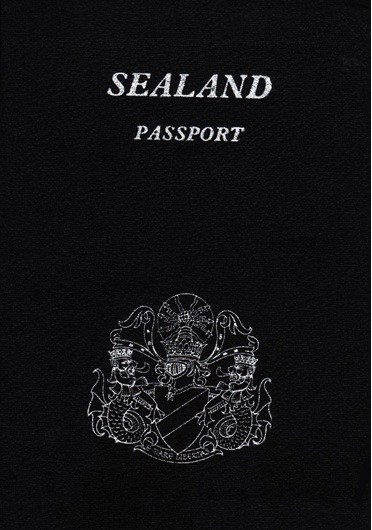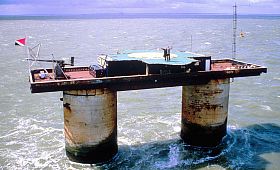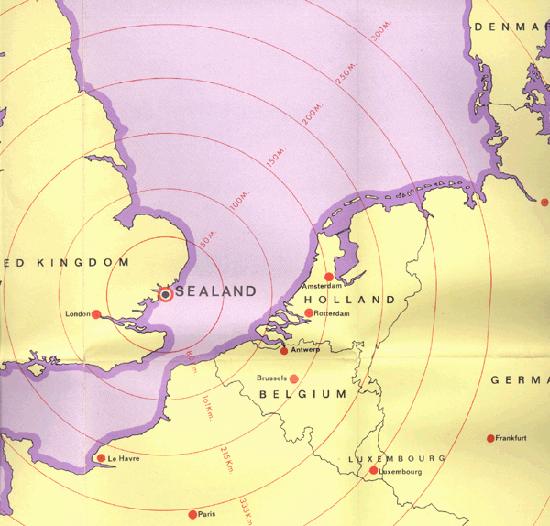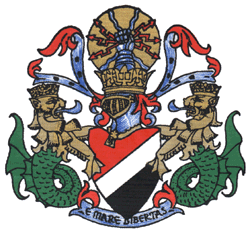Passport of Sealand.

In 1997, forged Sealand passports started tuning up around the world.
Some of these were used to open bank accounts under false names in various countries.
Since few people have ever seen a legitimate Sealand passport (less than 300 exist today) it was difficult for these to be easily detected as forgeries.
The source of these forgeries was traced back to the same German man who was involved in the earlier attempt to take Sealand by force.
Dubbing himself Minister of Finance, he had created a fake Sealand Business Foundation and boasts that he has sold over 150 000 fake Sealand Passports to all comers.
Thus there are now unfortunately 500 times more forged Sealand Passports in circulation than real ones.
Many of the forged passports were apparently sold to people leaving Hong Kong at the time of Chinese reoccupation for USD 1 000 each.
About Sealand

Sealand was founded as a sovereign Principality in 1967 in international waters, six miles off the eastern shores of Britain. The history of Sealand is a story of a struggle for liberty. Sealand was founded on the principle that any group of people dissatisfied with the oppressive laws and restrictions of existing nation states may declare independence in any place not claimed to be under the jurisdiction of another sovereign entity. The location chosen was Roughs Tower, an island fortress created in World War II by Britain and subsequently abandoned to the jurisdiction of the High Seas.
The independence of Sealand was upheld in a 1968 British court decision where the judge held that Roughs Tower stood in international waters and did not fall under the legal jurisdiction of the United Kingdom. This gave birth to Sealand's national motto of E Mare Libertas, or "From the Sea, Freedom".
The official language of Sealand is English and the Sealand Dollar has a fixed exchange rate of one U.S. dollar. Passports and stamps have been in circulation since 1969 and the latter decade of the 20th century saw an impressive expansion in its activity both socially and industrially as it began to develop a growing economic base which underscored its long-standing membership of the international community of States.
History Of Sealand
The Heritage
During the Second World War the British government built several Fortress islands in the North Sea to defend its coasts from German invaders. These forts were built illegally in international waters.
One of these Fortresses, consisting of concrete and steel construction, was the famous royal fort Roughs Tower situated slightly north of the estuary region of the Thames River. In contrast to the original plan to locate the tower within the sovereign territory of England, this fortress was situated at a distance of approximately 7 nautical miles from the coast, which is more than double the then applicable 3 mile range of territorial waters; to put it briefly, this island was situated in the international waters of the North Sea.
The forts were abandoned in the early 1950’s and whilst built in international waters in a time of world crisis, they should have been pulled down to comply with international law. Except for the aforementioned fortress, the fortresses were subsequently pulled down. This resulted in the portentous uniqueness of the fortress. Fort Roughs Tower, situated at the high seas, had been deserted and abandoned, res derelicta and terra nullius. From a legal point of view, it therefore constituted extra-national territory.
The Birth of Sealand

In 1966 Roy Bates a former infantry major in the first battalion Royal Fusiliers whose regimental headquarters strangely enough was the “Tower of London” decided to take over the fortress. It was Christmas Eve 1966.
Roy smarting from a legal battle with the British government over his offshore radio station “Radio Essex” which had broadcast from another abandoned fortress that was found by the British courts to be within UK jurisdiction. These stations were known affectionately by the press as “Pirate” radio stations and were much loved by the British public as they supplied everything that the BBC did not at the time, Pop music and amusing presenters.
Roy never did bring his radio station back to life but instead after taking much advice from his lawyers had the idea to declare this fortress island the independent state of “Sealand”. Claiming “Jus Gentium” over a part of the globe that was Terra Nullius.
2nd of September 1967 along with his son Michael (14), daughter Penelope (16) and several friends and followers Roy declared The Principality of Sealand raising a newly designed flag and making his beautiful wife “Princess Joan”. It was her birthday and Roy gave her the best and most romantic present he could think of the title of Princess.

Initial Challenge to Sealand's Sovereignty
It was not long before the British Government decided they could not have what ministers described as a possible Cuba off the east coast of England. They sent the military out to destroy other forts that were left in international waters. The Bates family looked on as huge explosions sent the massive structures hundreds of feet in the air and debris floated past for days.
Helicopters that had carried the explosives buzzed above and the navy tug carrying the demolition crew passed close by and shouted “You’re next!”. A while later a government vessel passed close by its crew shouting threatening obscenities at Michael and his sixteen year old sister. Warning shots were fired across the bow of the boat and it raced away towards the UK.
Since Roy was still a British citizen a summons was issued under the fire arms act and on the 25th of November 1968. Roy and Michael were in the dock of the Crown court of Chelmsford assizes in Essex. There was much argument and laws going back to the 17th century were called upon. During his summing up the judge said “This is a swash buckling incident perhaps more akin to the time of “Sir Francis Drake” but it is my judgment is that the UK courts have no jurisdiction.” This was Sealand’s first de facto recognition.
 Cyprus
Cyprus
 Cyprus
Cyprus
 In 1997, forged Sealand passports started tuning up around the world.
In 1997, forged Sealand passports started tuning up around the world.
 Sealand was founded as a sovereign Principality in 1967 in international waters, six miles off the eastern shores of Britain. The history of Sealand is a story of a struggle for liberty. Sealand was founded on the principle that any group of people dissatisfied with the oppressive laws and restrictions of existing nation states may declare independence in any place not claimed to be under the jurisdiction of another sovereign entity. The location chosen was Roughs Tower, an island fortress created in World War II by Britain and subsequently abandoned to the jurisdiction of the High Seas.
Sealand was founded as a sovereign Principality in 1967 in international waters, six miles off the eastern shores of Britain. The history of Sealand is a story of a struggle for liberty. Sealand was founded on the principle that any group of people dissatisfied with the oppressive laws and restrictions of existing nation states may declare independence in any place not claimed to be under the jurisdiction of another sovereign entity. The location chosen was Roughs Tower, an island fortress created in World War II by Britain and subsequently abandoned to the jurisdiction of the High Seas.
 In 1966 Roy Bates a former infantry major in the first battalion Royal Fusiliers whose regimental headquarters strangely enough was the “Tower of London” decided to take over the fortress. It was Christmas Eve 1966.
In 1966 Roy Bates a former infantry major in the first battalion Royal Fusiliers whose regimental headquarters strangely enough was the “Tower of London” decided to take over the fortress. It was Christmas Eve 1966.
